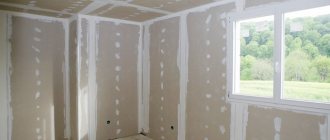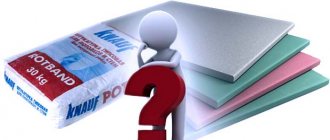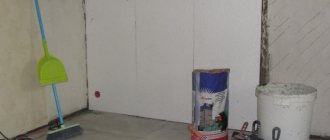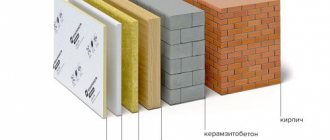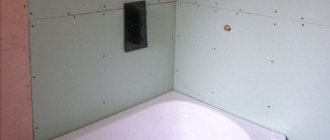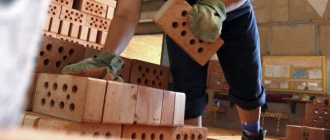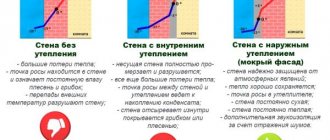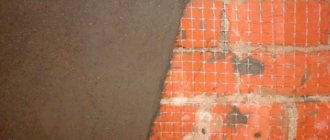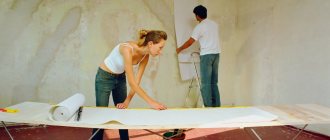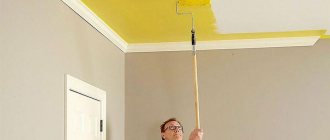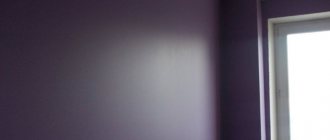Drywall
Otherwise, this material is called dry plaster , and it is used very widely in interior decoration. Thanks to this material, walls, slopes, and ceilings are leveled. Like any other finishing materials, drywall has its advantages and disadvantages.
All the positive qualities of this material are divided into operational and technical . Many people plan to do apartment renovations on their own, but it can be noted that not all materials are as easy to install as drywall.
Drywall has the following advantages:
- Simple installation , even a beginner can quickly understand the features of working with drywall;
The light weight of the material allows it to be mounted alone, despite the fact that the whole sheet has a large area.
The performance characteristics of the above materials are also excellent, but several main ones can be distinguished. For example, unlike wood, plastic, and other materials, drywall does not emit toxins in case of elevated air temperatures. In addition, the material is environmentally friendly and also consists of gypsum, which is covered with paper. The material can easily maintain a good microclimate in the room. Under the material you can place various communications and other materials, and the room will become even more comfortable and protected. The material has numerous design possibilities that allow ideas to be realized.
Insulating walls: step-by-step instructions
There are many types of insulation, any of them can be done with your own hands; for this you will need drywall, mineral wool, self-tapping screws, a building level, a hammer drill and, in rare cases, an angle grinder.
At the stage of planning and assessing a room, it is necessary to take into account its full dimensions in order to calculate the exact amount of materials purchased. The number of profiles is determined a little differently, namely, the length of the insulated wall is taken and divided by 40 cm.
Antiseptic treatment
This stage of work is of particular importance only for the reason that it greatly simplifies the remaining processes . It is recommended to use antiseptic solutions, since if the wall is affected by a fungal disease, then nothing will stop its impact. This, in turn, contributes to a decrease in the quality of the walls. If you insulate a brick wall from the inside with mineral wool, then you must strictly observe the basic details of the operations being carried out .
Marking, fastening
Careful markings are carried out around the perimeter of the wall that you plan to insulate. Otherwise, you will have to work hard. After the installation of the guides has been carried out, you need to make sure that you managed to achieve their placement in the same plane . To do this, you need to stretch two threads along the diagonals of the rectangle, which should touch each other. If the distance exceeds 1 cm, then everything must be done again.
Installation of supporting profiles
At this step there is a certain sequence of actions that are important to take into account, only then the installation will be of the highest quality and productive. It is necessary to repeat the operation until the ideal frame is made, then mineral wool is placed in the niches . Insulating walls with mineral wool from the inside is quite simple, since this material is sold in different densities . It is important to choose the right location of insulation, because in some cases it is irrational.
Drywall installation
When you insulate walls with mineral wool from the inside, you need to pay attention to high-quality and competent installation of drywall. This procedure is familiar to many finishers, and there is nothing complicated about it . The fitted sheet is installed vertically and then secured to the profiles using self-tapping screws. It is not recommended to make special efforts, since the distance between the screws should be about 30 centimeters.
Next, using sheets of plasterboard, the entire wall is covered and the seams are sealed. Then, the serpyanka is moistened with putty and pressed against the joint of the sheets. The joints must dry, then the surface must be finished. There are many options, since mineral wool and plasterboard go well with all materials. If you follow the basic recommendations for action, you can achieve optimal results.
Conclusion
Even an inexperienced builder and finisher can carry out the insulation procedure with his own hands if he follows all the recommendations indicated by us. Drywall and mineral wool are materials that combine perfectly and create a high-quality layer in the wall.
Technical features of gypsum boards
GCR itself is not an insulation material. Construction and finishing sheets have a thermal conductivity that is 10 times lower than that of reinforced concrete slabs and bricks, and 10 times higher than that of mineral wool. A piece screwed to the wall feels much warmer to the touch than conventional partitions. At low temperatures and no heating in the room, the surface is perceived as cold.
Insulation under sheets Source akvilon.ua
In order for gypsum board to insulate, it must be laid out in a thick layer of 20-30 cm. Such a structure will steal 40-60 cm of usable space from the room. The cost of purchasing sheet raw materials will be much higher than using mineral wool or polystyrene foam. Construction and finishing materials are best used in combination with heat insulators.
Insulation of walls under plasterboard is carried out using two technologies. Most often it is recommended to give preference to the frame method. In the room, a sheathing is assembled from a metal profile or wooden blocks, onto which the plasterboard is attached. The space between the partition and the wall is filled with a special heat-insulating material.
The frame method ensures the most effective insulation of the room and ease of installation. A correctly assembled “pie” will not only make the room warm, but also protect it from external noise. The technology has 3 disadvantages:
- Hiding the area. The lathing takes at least 10 cm from each wall, which is problematic for tiny rooms.
- Low mechanical strength. The structure does not withstand impacts well.
- Hanging heavy objects is prohibited. To neutralize the problem, additional guides have to be added to the sheathing.
In compact spaces, professionals use frameless technology. Plasterboard with insulation fixed directly to the wall can achieve a good thermal insulation effect. The materials are connected with a special adhesive and self-tapping screws. The partitions must be smooth and strong, otherwise installation difficulties will arise. It will not be possible to create a thick layer of thermal insulation.
Insulation without lathing Source wikipotolok.com
Types of drywall and its use
An example of insulating walls indoors with plasterboard
Articles on the topic - how to cut mineral wool correctly.
Drywall can be used to insulate walls inside a building. Use either moisture resistant or wall.
Moisture-resistant can be used in dachas or for rooms with a high degree of humidity: bathrooms and kitchens.
Important! Moisture-resistant plasterboard, the best solution for rooms where heating is not provided.
This material is not at risk of cyclical temperature fluctuations. After installing the sheets, you only need to apply a waterproof primer or protective paint to the front part. You should also treat drywall with an antiseptic to kill harmful germs and bacteria.
Wall types are suitable for living rooms where the humidity is no more than 70%. Sheets are marked in blue on a gray surface.
As for the sizes of sheets, it is best to purchase products 2.5-3 meters long and 1.2 meters wide. In terms of thickness, canvases of 12.5 mm are perfect (9.5 mm is the ceiling type).
Drywall is:
- ordinary;
- moisture resistant;
- moisture and windproof;
- enhanced strength;
- fire resistant.
Frame insulation method
Related article: Independent insulation of balcony walls from the inside.
There are 3 methods of insulation:
- Glue method. The sheets are attached directly to the wall using gypsum or polymer-cement glue. With this finishing, the area of the room does not become smaller. The only disadvantage of this method is that it is impossible to lay thermal insulation, and the walls must be strong.
- Frame method with thermal insulator.
- Frame method without insulation.
The last two methods of installing drywall are used most often. In order not only to insulate the room, but also to achieve good sound insulation performance, you will need to use profiles. The only drawback is that the room is significantly reduced in size.
Installation algorithm
Thermal insulation of internal partitions using gypsum plasterboard does not require high qualifications from the performer. For the work, standard skills and universal equipment that you have at home are sufficient. Let's look at the algorithm of actions in detail.
Preparation
At the first stage, the walls are cleaned of dirt and dust. We recommend filling large cracks and unevenness in partitions with putty. Protruding fasteners and remnants of reinforcement must be removed. The surface is treated with an antibacterial solution and dried thoroughly.
Frame assembly
It is more convenient to do marking work with a laser rangefinder, although a regular plumb line will do. The sheathing is assembled from a metal profile or wooden blocks. Before the procedure, natural material is coated with antifungal impregnation, otherwise it will rot over time.
The starting strip is glued to the floor with tape. Vertical guides are screwed to the profile with self-tapping screws and to the wall with dowels. The ends of the parts are fixed with fleas. There should be 4 slats for each gypsum board sheet.
The finished structure is stable. Cross bars improve the rigidity of the frame. The length of the products overlaps adjacent guides by 50%. The blanks are fixed to the surface of the sheathing with fasteners.
Step-by-step algorithm for do-it-yourself insulation
Let's consider the procedure for internal wall insulation using plasterboard attached to the sheathing:
- Pre-clean surfaces from dirt and dust.
- If necessary, align them.
- Attach a metal guide profile to the walls. The width between the guides must be sufficient for installing tile or roll insulation.
- Be sure to use a vapor barrier layer.
- Insulate the wall surface with the selected type of insulation.
- Cover the structure with sheets of plasterboard.
Installation of a profile frame for insulation
To mount the frame, you will need the following list of materials:
- ceiling profile 60*27;
- guide profile 28*27;
- straight hangers;
- self-tapping screws;
- set of dowels 6*33.
Video description
How to assemble a plasterboard partition with insulation with your own hands.
Insulation
The vapor barrier membrane is installed first. Thermal insulating material is inserted into the free space (“windows”) of the frame. Mineral or glass wool is attached using special foam, which is applied around the perimeter and in the center of the mat. For reliability, the raw materials are screwed with self-tapping screws.
After installing the vapor barrier, foam and polystyrene foam are mounted with glue. The slabs, prepared to size and treated with the composition, are fixed to the wall. All joints are taped with construction tape. The holes between the material and the ceiling are sealed with silicone-based sealant.
When installing isolon, a membrane is not needed. The raw materials are cut into pieces before the procedure. The sheet is placed with the foil side in the room. The vapor barrier is glued with the rough part facing inward.
Installation of mineral wool Source zen.yandex.com
Technology of thermal insulation of walls with plasterboard from the inside
The technology of insulating the walls of a room with plasterboard from the inside does not require special training of workers or expensive equipment. General construction skills and a universal tool are enough.
Tools and materials
During the work you will need:
- guides (metal profiles or wooden bars);
- gypsum boards;
- insulation in slabs or rolls;
- double sided tape;
- vapor barrier membrane;
- screws, dowels and other fasteners;
- anti-mold agents;
- putty;
- drill;
- screwdriver;
- hand tool.
The floor in the room must be cleared of debris and foreign objects.
Design
At this stage, the type of insulation, gypsum board and guides is selected.
If you are insulating a kitchen or bathroom, you should choose moisture-resistant plasterboard. For the boiler room, it is recommended to use fire-resistant.
Wooden guides are cheaper, but they are at risk of drying out and deforming in the event of temperature changes. The metal profile does not have such disadvantages. The number of guides is calculated based on a standard step of 60 cm.
When calculating the volume of materials purchased, a 5% reserve should be made in case of damage to gypsum boards and for cutting complex elements of walls and ceilings.
How to install insulation under drywall: 3 options for Russian
In fact, the technology of insulating walls with plasterboard from the inside largely depends on the wall itself, that is, on its thickness and the presence of insulation from the street. However, the installation technique itself does not depend on these parameters and remains unchanged, so I want to fix the main direction precisely on the technical conditions.
I will tell you about three possible and simple methods, materials and show a video in this article.
Insulation under gypsum plasterboard
A few words about drywall: it can be wall (GKLS), ceiling (GKLP), moisture-resistant (GKLV) and fire-resistant (GKLO). In addition, there are also reinforced gypsum fiber sheets (GKL) and gypsum fiber moisture-resistant sheets (GVLV).
About materials and efficiency
Foam panels of different thicknesses
By and large, two insulation materials are used for gypsum plasterboards: polystyrene foam and mineral wool:
- foam plastic is a material made by filling plastic with gas and in this case, these are panels 1000×1000 mm and thicknesses of 20 mm, 30 mm, 40 mm, 50 mm and 100 mm;
- there are two types of density, which is used in domestic and most industrial premises - these are 15kg/m3 and 25kg/m3 (its price is higher);
- So, in terms of thermal conductivity there is little difference, but this is very clearly visible during installation - the fifteenth sheets crumble heavily when cutting, crumbling into granules, while the twenty-fifths behave quite decently;
- The thickness of the panels is selected depending on the needs in a particular case.
Mineral wool is an excellent insulation material
Mineral wool comes in different forms:
- such a general concept as mineral wool can imply three types of material, that is, made from different melts - GOST 31913-2011 (EN ISO 9229:2007);
- there is glass wool, which is made from molten glass waste, quartz sand and other materials that are used to make glass;
- there is slag wool - such a product is made from melts of blast furnace slag, which, naturally, remains in the metallurgical industry;
- there is stone wool - it is made from molten basalt (this is volcanic lava) and the product itself has a gray-yellow color;
- in addition, any mineral wool can be foil-coated on one side, and also produced in rolls or in blocks (panels).
Sheathing with plasterboard
- Before installing plasterboard sheets, a vapor barrier layer should be installed. There are a variety of vapor barrier options available on the market, although all of them are actually plastic film. It is installed in rows with an overlap of 10-12 cm, the joints of the rows are glued with special tape. The result should be a continuous film sheet without holes or gaps.
- After this, installation of the casing begins. A sheet of drywall is attached to the guides using standard means - self-tapping screws with a drill tip or ordinary ones in pre-prepared holes, after which the caps and joints are carefully puttied and rubbed until a uniform plane appears.
Insulating walls with plasterboard solves thermal insulation issues and protects materials from failure. The cost of this method is much lower, and the result often looks better than before.
How long will the insulation last?
The service life of insulation depends on its type. Cheap materials are on average suitable for use for 20-30 years. Some expensive brands have a service life of up to 50 years in their technical specifications (but this is not always tested in practice).
Over time, the substance ages, the structure of the material is destroyed, it dries out or cakes, and loses more than 1/3 of its thermal insulation properties. Most types of insulation are recommended to be replaced at least every 35 years.
To create a healthy, favorable microclimate in the house, you can independently carry out the work of insulating the internal walls. For this purpose, lightweight, easy-to-install materials are used. With their help, you can make high-quality wall repairs with your own hands, even without professional training, using tools available in everyday life.
Isolation stages
First you need to clean the wall. At the same time, do not just listen to the advice: cleaning-drying-washing. This, of course, is hassle-free, but, unfortunately, not everything. The more thoroughly the work surface is prepared, the better the result will be.
Related article: Photo wallpaper on the wall
You need to make sure that no moisture gets on the wall. It is this factor that will allow you not to worry about the condition of the base under the insulation for quite a decent time.
After cleaning, saturate the walls with antiseptics or fire retardants - special impregnating solutions. (This kind of work must be done with wood!)
The wall needs to be leveled if it has significant bumps, and also pay attention to ensure that there are no gaps or cracks. Because all this will allow heat to pass through, preventing the insulation from performing its task.
Frame construction
Many thermal insulation materials can be glued directly on site. However, do not forget that you still need to mount the outer sheets. Therefore, to do this, you need to make a supporting frame, on the slats of which the drywall itself can then be fixed.
Traditionally, the frame is mounted from wood, however, in my opinion, there are two significant disadvantages:
- The weight of the constructed frame can be quite decent. Provided that the walls are made of cellular concrete, serious difficulties with fastening may arise.
- The frame is made taking into account the technical characteristics of the selected insulation. The design again turns out to be extremely heavy and only adds to the problem.
Therefore, experts advise buying profiles specifically for laying under drywall; this will save time and effort. The best option is galvanizing. Profiles made of this material can even be cut with scissors.
When attaching profiles, you need to look at the dimensions of the drywall sheets. The profiles themselves can be mounted both horizontally and vertically. Before laying the profiles, you need to stick a special tape on the frame. This will have a good effect on sealing the joints, reduce heat transfer and can help avoid deformation of the slats.
You need to control the alignment vertically and horizontally, this will guarantee a flat surface.
Laying insulation
When you already have a frame, you can lay the material in the resulting “cells”. Installation details depend on the type of insulation you have chosen. If you are working with foam plastic, then do not forget about fixing it with dowels.
Important! All joints must be sealed! The joints of the slabs are taped with construction tape, and between the slabs and the ceiling are treated with construction sealant.
At this stage, I advise you to watch a video that will provide specifics specifically for your material.
Related article: Vegetable garden on the balcony: everything you need to know for beginners
Laying vapor barrier material
Vapor barrier material protects against moisture accumulation in unnecessary places. Typically, a vapor barrier is a film coated with foil. The shiny side should be facing the interior wall of the apartment. The vapor barrier sheets must be overlapped. For greater guarantee, seal the joints with metallized tape.
Sheathing with plasterboard
After the stage of laying the vapor barrier is completed, you can begin covering with plasterboard. It is made with self-tapping screws. The joints of the sheets must be puttied, then treated with sandpaper and covered with some kind of paint and varnish composition or glued with tape. This will help prevent the putty from cracking.
A few recommendations so that you have an idea of some of the nuances.
- When choosing insulation materials for drywall, be sure to pay attention to their dimensions so as not to waste time cutting and adjusting something again.
- There should be as few joints as possible. This will keep the apartment warm.
- If communication lines pass along the wall, please note that the insulation must be under them.
- To ensure that the natural air circulation in the room is not disrupted, leave a small gap between the frame slats and the insulation.
In conclusion, I will say that insulating walls with plasterboard has many advantages. This not only preserves heat in your home, but also provides good sound insulation, which is important if you live near a railway, noisy street or tram line. Anyone can carry out such insulation on their own; it is important to be patient and attentive.
Installation of gypsum board sheets
If working with drywall is new to you, you need to first familiarize yourself with some of its features. Before installing the guide profiles, a special tape is laid along the intended installation lines. It will serve as protection against contact with plaster. In this case, the drywall will be protected from the cold that comes from the metal profile.
Metal profiles are usually installed at a distance of 2 cm from the wall. It is recommended to install a frame made of galvanized profile. After installing the frame, insulation boards are placed behind it. The material must be inserted vertically. In no case should the edges of the insulation protrude beyond the front side of the profile.
Why is wall insulation done?
The problem with cold walls is not so much the lack of comfort as the formation of condensation and wetting of wall materials. If this happens, the moisture in the thickness of the wall will sooner or later freeze and begin to expand, causing the destruction of the material. This can only be avoided with the help of insulation.
There are two ways:
- External method. The insulation is located on the outside, cutting off cold outside air from the wall materials. At the same time, the temperature of the walls increases significantly, heat loss is reduced, and the formation of condensation stops. In addition, the inner surface of the walls remains intact.
- Internal method. The insulation is installed from the inside, cutting off warm internal air from the wall material. Only the insulation layer is responsible for maintaining heat. A problem is created with the removal of steam, since it cannot be allowed to penetrate into the insulation under any circumstances, so a continuous vapor barrier film impenetrable to steam is needed. This significantly increases the air humidity inside the room, which requires the organization of high-quality ventilation.
It is believed that the best option is external insulation, but often this option is not possible. For example, the external surface is inaccessible (upper floors, prohibition on changing the appearance of the building, nearby structures, etc.). In this case, you have to insulate from the inside, which in some sense is more convenient - for example, you can work at any time of the year and in any weather.
What materials can be used inside for insulation under gypsum boards?
First you need to choose the right brand of drywall, because not all are suitable for this purpose.
Drywall is:
- wall;
- ceiling;
- fire resistant;
- moisture resistant;
- reinforced gypsum fiber;
- moisture-resistant gypsum fiber.
Moisture-resistant, high-strength, fire-resistant grades of plasterboard are suitable for wall insulation. Purchasing products from well-known manufacturers is a guarantee of the quality of materials.
The thermal insulation properties of the walls and material costs depend on the choice of insulation. Insulating products are used in different densities, thicknesses, hard and soft, and have different thermal conductivity values.
Advantages and disadvantages
The undoubted advantage of insulation under plasterboard is the geometrically ideal surface of the walls and fairly high thermal insulation efficiency. The disadvantage is that the thickness of the frame for attaching drywall “eats up” part of the area of the room, which is very important or simply unacceptable for a small room. It should also be noted that plasterboard has a low load-bearing capacity: heavy shelves and other interior elements cannot be hung on it. This problem can be solved by installing additional vertical frame profiles or anchors attached to the wall through sheets of drywall.
What insulation to use
To prevent convection air flows and increase the thermal resistance of the walls, the frame cells are filled with thermal insulation material.
The most common types of insulation used as insulation under plasterboard sheets:
- Styrofoam. Now they often write about its dangers (along with polystyrene) for health. It is rarely used in residential premises. The second disadvantage is that rodents eat it. But this type of material is cheap and available in many sizes and densities.
- Stone wool. The advantages of mineral wool include lightness (especially important for insulating old buildings), as well as low thermal conductivity. The air layer that appears between the mineral fibers turns this material into a kind of thermos. There is only one significant drawback of mineral wool - hygroscopicity. Therefore, when thermally insulating the walls of premises from the inside, it is necessary to prevent the accumulation of condensate and provide a vapor barrier.
- Glass wool. Made from thin glass fibers. Has a number of disadvantages:
conclusions
If you approach wall insulation responsibly, you can create an atmosphere of comfort in any apartment. We hope that our simple instructions will help you implement this plan. Good luck.
It is not easy to make thermal insulation of a multi-storey building; special equipment is required. But insulating the walls inside with mineral wool or plasterboard gives a good effect. With proper installation, heat loss is reduced by 20-30%. The main thing is that the thermal insulation layer in the room corresponds to the technology. We will tell you in this article how to properly insulate walls from the inside of a living room with plasterboard.
